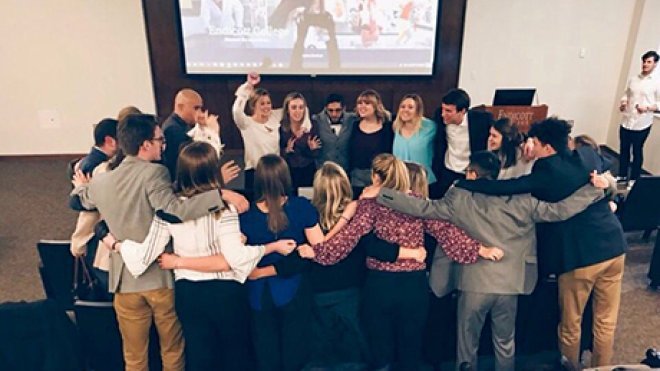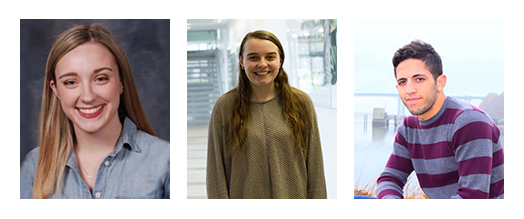‘You Get What You Put In': RWU Students on this Year’s Student Advertising Competition Course
After securing a second-place finish for project-based course work, students reflect on their experience and what they got out of the class

BRISTOL, R.I. – As a part of their Advertising Campaigns Practicum course, 26 interdisciplinary students worked on a yearlong project developing a fully integrated advertising campaign for Ocean Spray.
Students presented their campaign in the regional round of the American Advertising Federation’s National Student Advertising Campaign Competition. The RWU team placed second in the competition for a second year. It was the team’s third consecutive year placing in the top three and the sixth time placing in the top four in recent years.
To give a sense of the experience students came away with, three seniors reflected on the class and their favorite campaign elements.
What the Course is Like
Julia Palardy, marketing: The class basically functions like a small-scale agency. I had an internship at an agency, but I feel like I had more agency experience in this class, because it’s so much more hands-on.
Acacia (Cacey) Longley, marketing: It’s a full start-to-finish entirely new campaign.
Nicholas Barbaria, graphic design: One of the students that took this class last year jokingly said that this class was a full year of work experience. And you know what? I agree.

Campaign Foundations
The two-part class Marketing 401 Advertising Campaigns Research and Marketing 402 Advertising Campaigns Practicum, both taught by Assistant Professor of Marketing Geraldo Matos from the Mario J. Gabelli School of Business, is centered around the National Student Advertising Campaign. Each year AAF enlists a corporate sponsor – like Ocean Spray – to provide a case study that identifies a real-world problem.
Julia: We spent the whole first semester doing research.
Cacey: We were split into three research teams. I was on the primary research team, so we conducted surveys, interviews, store visits and things like that while the competitive team figured out where Ocean Spray would fit in the market. The secondary research team looked at research that already existed.
Campaign Elements
After establishing the direction of the campaign, students broke into creative and brand management teams to create the elements of the campaigns such as TV spot commercials, digital/social media posts, traditional advertisements on subways and buses, and a 21-page document that is the brand overview of the entire campaign.
The all-around class favorite campaign element was the 60-second brand manifesto, which sets the framework for the brand story.
Cacey: I cry every time I see it.
Julia: Everything was shot by the class. None of it is stock.
Nicholas: Literally the third week of school we took a group of four students and went to a few bogs. We didn’t know what we were looking for but we just took as many shots of what we could and we got to talk to some of the farmers. We discovered some pretty interesting information about cranberries that you’re not going to find online or through a survey that actually ended up making it into the campaign. It’s all about authenticity.
Cacey: We wanted to make sure all the videos embody the appropriate lifestyle while also incorporating Ocean Spray products, but at the same time not making it super product focused. We wanted it to be like the products are just integrated into their lives.
Final Reflections
Despite not winning the competition, the students in Matos’ class walked away with more than just a trophy. They walked away with traits and skills favored by top organizations. Julia and Nicholas used their experience in the class in interviews that led to full-time positions. Cacey said this class helped her secure a position at Havas Media in Boston as a digital investment associate.
Julia: It’s about what you do with the experience.
Cacey: It’s crazy talking it all out. When we were doing it kind of felt like we were making decisions on the fly, but there was so much strategy that went into it. This whole semester was a blur. We had a lot of late nights, but it was the best experience of my life. We really got out of it what we put into to it.
Nicholas: At the end, you have this body of work that is unmatched. I’m very happy with what we made and what we have. I’m very proud of it. It’s helped me get a great job.
The Marketing 402 Advertising Campaigns Practicum class is comprised of 26 RWU students. Their majors included marketing, management, graphic design, communications, public relations, and a foreign language and marketing double major.
Seniors in the class are Nicholas Barbaria, Amanda Calderon, Jonathan Chow, Gabrielle Ciarleglio, Makayla D'Urso, Tiffany Eaton, Christy Gordon, Stephen Gross, Luke Herritt, Matthew Holman, Meghan Huston, Jillian Lewandoski, Acacia Longley, Lindsey Lopez, Nicholas Malone, Carolyn O'Hara, Julia Palardy, Zoe Siegel and Meghan Smith.
Juniors in the class are Grace Alpert, Ross Andrei, Christina Driscoll, Harper Smith, August Solone, Emily Warrington and Katherine Worth.
Seniors Jaime Warlich and Lily Englund were involved in the early conceptual development of the campaign.